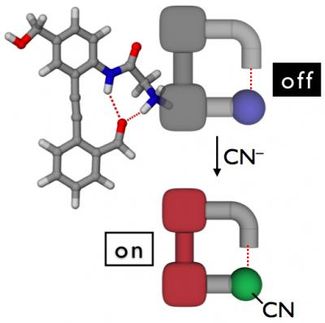How to count the messenger out
Mapping the structure of protonated water clusters
water molecules are continuously forming short-lived networks called clusters. These can in turn bind positively charged protons, and such clusters can provide active functional groups in proteins. Using infrared spectroscopy, it is possible to determine the bond strengths, geometrical structures and chemical properties of protonated water clusters. In order to measure the spectrum of molecular vibrations in clusters it is, however, necessary to use other molecules as messengers. A team of physicists and chemists including Dr. Gerald Mathias of Ludwig-Maximilians-Universität (LMU) in Munich and Professor Dominik Marx of the Ruhr-Universität Bochum has, for the first time, described how these messengers influence the assignment of spectral bands by infrared spectroscopy. "The results will improve our ability to interpret spectroscopic data", says Mathias, "and that is an important step towards a better understanding of the function of protonated water clusters in proteins. Because water molecules can be found virtually everywhere, the new findings will also have a positive impact on studies devoted to atmospheric chemistry and interstellar chemistry."
Water molecules don't like to be alone. The reason for their gregariousness is that they are polar. This causes neighboring water molecules to attract each other, forming so-called hydrogen bonds that link them into chains or clusters. Members of such clusters are restricted in their movements. That is why evaporation of water requires the input of relatively large amounts of energy: the energy is needed to break hydrogen-bond networks apart. Protonated water clusters, which have protons (positively charged hydrogen nuclei) bound to them, are important model systems for the investigation of proton hydration in aqueous solutions, the process that determines the acidity (pH) and electrical conductivity of water.
The smallest protonated water cluster is the hydronium cation, which consists of a single water molecule with an associated proton. Its chemical formula is H3O+. The so-called Zundel ion has a rather more complicated structure: here a single proton is shared by two water molecules. It is possible to determine the properties of various types of water clusters with the aid of infrared spectroscopy. When molecules are irradiated with infrared light, they vibrate in ways that depend on the wavelength (the color) of the light. The frequency of the resulting vibrations allows one to deduce the three-dimensional structure of the molecule and the strength of the bonds between its atoms.
In order to measure the vibrational spectra of water clusters in the gas phase, one needs to use small molecules or one of the noble gases, such as neon or argon, as messengers. These adsorb to the clusters and transmit their vibrations, allowing them to be detected more easily. "These spectra may be modified by the messenger molecules, so that it is important to understand their interactions with the clusters", says Dr. Gerald Mathias of the Faculty of Physics at LMU. Together with Professor Dominik Marx's group at the Ruhr-Universität Bochum, Mathias has now shown that the messengers have unexpected effects on the absorption bands in the spectrum of even the simple hydronium cation. However, by simulating the dynamics of the complexes formed between protonated water clusters and messenger molecules, the team was able to extract the real spectra for the cation from the raw data obtained in the presence of the messengers.
"The results obtained with the Zundel ion which is constantly changing its form were even more interesting", says Mathias. "We were able to show that this structure exists in two different forms. In one, the messenger is tightly bound to the cation, in the other it is only loosely associated with it and orbits around it. In the latter case, we observed that the infrared absorption spectrum was practically identical to that calculated for the unbound Zundel cation – so that these spectra are not influenced by the presence of the messenger molecules." This result provides a better understanding of experimental messenger spectroscopy, which is used for chemical analyses of the components of Earth's atmosphere and to detect molecules in interstellar space. The researchers hope that it will also provide new insights into the structure and function of protonated water clusters in proteins.
Original publication: Angewandte Chemie online, 23 August 2010
See the theme worlds for related content
Topic World Spectroscopy
Investigation with spectroscopy gives us unique insights into the composition and structure of materials. From UV-Vis spectroscopy to infrared and Raman spectroscopy to fluorescence and atomic absorption spectroscopy, spectroscopy offers us a wide range of analytical techniques to precisely characterize substances. Immerse yourself in the fascinating world of spectroscopy!

Topic World Spectroscopy
Investigation with spectroscopy gives us unique insights into the composition and structure of materials. From UV-Vis spectroscopy to infrared and Raman spectroscopy to fluorescence and atomic absorption spectroscopy, spectroscopy offers us a wide range of analytical techniques to precisely characterize substances. Immerse yourself in the fascinating world of spectroscopy!
























































